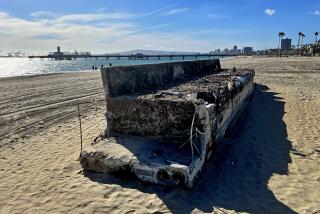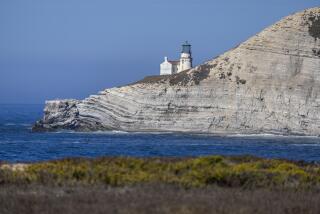Reef or Madness?
- Share via
An outlawed artificial reef, made of old tires and PVC pipe, bobs on the ocean floor off the Balboa Pier as its creator tries one last time to persuade state regulators to spare the structure.
Aquaculturist Rodolphe Streichenberger was denied a permit two years ago and never asked for one when the experimental reef was built in 1988, but he remains undeterred. Streichenberger will plead his case for the unorthodox mussel-breeding habitat at a one-hour workshop Wednesday in Los Angeles, an event the California Coastal Commission promised to hold when they turned down his permit application.
Unless the 10-acre reef gets an unlikely reprieve, the commission could order it dismantled, an edict Streichenberger said he would fight till the bitter end in the courts.
“They are so obstinate,” Streichenberger said of the commission in charge of coastal development.
An economist by trade, Streichenberger founded the Marine Forests Society and built the artificial reef as a research lab for his plan to “ranch” the ocean floor by breeding mussels, which he believed could provide a cheap source of food.
The lab consists of 1,500 used tires, 2,000 plastic gallon jugs and 100 20-foot sections of PVC pipe known as “mussel columns.”
Typically, artificial reefs are made of large stones, but Streichenberger argues that using recyclables is environmentally superior to mining rock quarries.
The Coastal Commission in 1997 rejected Streichenberger’s after-the-fact permit application for the project, ruling that it was “inconsistent” with state resource protection policies.
“Their employees are not doing the right thing in denying [the permit] for stupid reasons,” Streichenberger said.
Before the Coastal Commission acted, state Fish and Game officials determined that the experiment was unlikely to ever lead to a “viable aquaculture project.”
Streichenberger insists, however, that the artificial reef is a wonderful breeding ground for mussels, which are flourishing in the unconventional habitat.
“It’s very successful,” he said.
Wednesday’s hearing will include testimony from a Fish and Game official in charge of artificial-reef programs and a UC Santa Cruz ecologist and marine biologist.
The dispute started in 1993, when Streichenberger filed for a permit to submerge 30,000 more tires for another experiment. The application alerted the Coastal Commission to the fact that Streichenberger already had created an unapproved saltwater reef of tires, bottles and various other discarded materials.
Coastal Commission ecologist John Dixon said that the jugs, pipes and floats in the reef don’t pose an environmental risk but that they do require “constant maintenance.”
“I don’t think they are damaging in the sense of hurting the environment, but they’re permanent, so they’ll end up someplace, probably as debris on the beach, if they are not maintained,” he said.
(BEGIN TEXT OF INFOBOX / INFOGRAPHIC)
Shellfish Forest
Below are three types of structures built on the ocean floor off Newport Beach by the Marine Forests Society to replace lost marine habitat.
More to Read
Sign up for Essential California
The most important California stories and recommendations in your inbox every morning.
You may occasionally receive promotional content from the Los Angeles Times.













